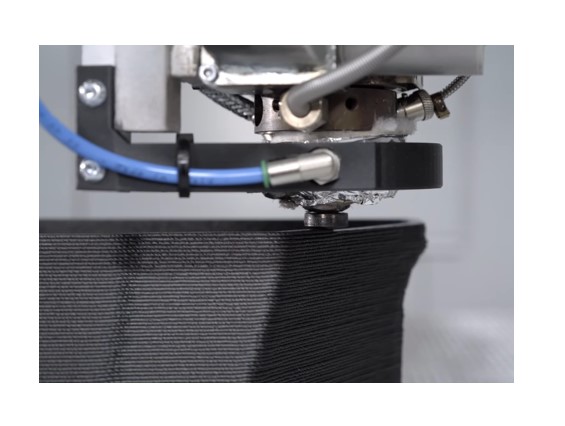Few technological advancements truly deserve to be called innovations. The CMS Kreator is one of the lucky ones.
This state-of-the-art hybrid manufacturing system fuses 5-Axis milling with Screw Extrusion Additive Manufacturing (SEAM) to deliver unparalleled efficiency, flexibility and quality. Put simply, the system is designed to quickly build composite jigs, fixtures and tools that are lighter in weight than aluminium counterparts.
“The Kreator has quickly become a favourite machine in the range. Basically, it’s a classic 5-axis large-format CNC machining centre, integrated with large-format additive manufacturing. In this day and age, sourcing reliable suppliers of composite parts or tools proves to be a challenge, this is incredibly useful and a game-changer. Just imagine printing your part and achieve a high-quality finish within the same machine frame. It’s a major selling point for the Kreator,” says Anthony Cruz, Advanced Materials and Plastics expert for Innovync.
Developed by the Italian firm CMS, in partnership with Germany’s prestigious Fraunhofer Institute, The Kreator expands the possibilities for Advanced Materials and Plastics manufacturing. With the fusion of CMS’ already excellent milling capabilities, plus the ability to 3D print large-format parts, tooling and moulds become far more economical to produce. The concept is to empower manufacturers to produce at premium quality in the leanest possible way, streamlining the manufacturing process while boosting material and weight savings. The result is quicker and easier material supply, leading to more sustainable production.
That positions it perfectly for rapid prototyping in the automotive, marine, and aerospace sectors. These industries use high-performance materials and require precision for optimal results. Usually, the high cost of these requirements would drive firms to seek offshore production. Not anymore.
The CMS Kreator’s hybrid technology is designed to cater to a wide range of applications and industries. Its versatile build volume, ranging from 3x2x1m to a massive 10x4x2m, allows you to create parts in various shapes and sizes. What’s more, the system enables vertical 0°, 45°, and 90° 3D printing, making it an all-round manufacturing solution for your business.
Capable of processing an array of thermoplastic fibre-reinforced polymers including PLA, PP, PET, PA, ABS, PC, PEI, PESU, and many others, the Kreator ensures compatibility with a diverse range of materials. An extrusion flow rate from 10 up to 100 kg/h facilitates optimal efficiency, pairing speed with precision.
CMS’ patented milling-to-printing automatic head change system eliminates the need for manual operation, streamlining production processes. Specialised slicing software has also been developed to manage print temperatures, minimise print time, and simplify the production process. The results speak for themselves. Material and weight savings of up to 80% are possible – a number that is far from insignificant. Especially in the current economic and logistics climate.
How much time and material would you save using this process? What would that mean for the oh-so-costly craft of mould production?
Now you see how powerful this milling-printing fusion is.
The very first Kreator is set to hit Australian shores next year, thanks to CMS’ local dealer, Innovync. The Sydney-based firm landed an exclusive distribution contract with CMS for Advanced Materials and Plastics back in 2020, adding to their Stone and Glass coverage. None of the machines in their range or any in Australia, for that matter – are quite like this one, especially on the printing front.
“The advantage of the Kreator, apart from its capabilities, is that it’s a high-quality equipment in itself. Additionally, there are not a lot of large-format hybrid machines that are on offer out there, leaving little competition to contend with. The primary stand-out feature is its ability to print and mill high-quality parts, especially for tools, patterns and mould-making”, says Anthony.
This is great news for composite manufacturers, more broadly: anyone who makes trimming and assembly jigs, machining fixtures, lamination masters and direct lamination moulds. The unique printing-milling pairing is so disruptive that it may even cultivate a new kind of manufacturing culture. Could we even go as far as to say that it has the potential to spur innovation and protect intellectual property?
Only time will tell. The real effects will only become evident once this new breed of machine flares into life. Until then, direct your questions to Anthony and the Innovync team – or follow the Kreator’s progress on their newsletter and socials.

